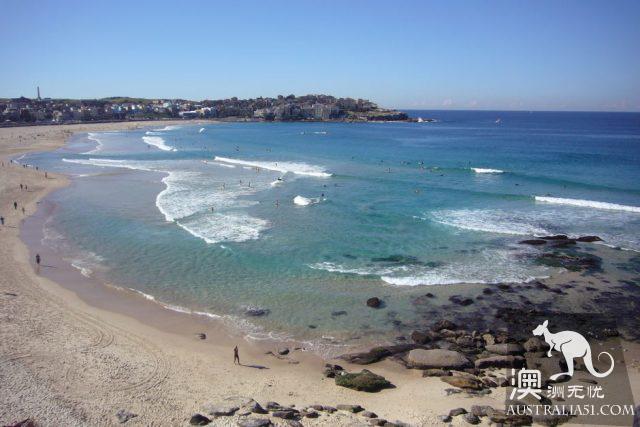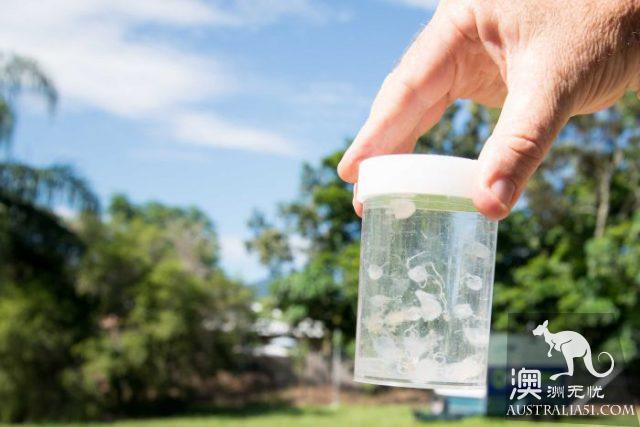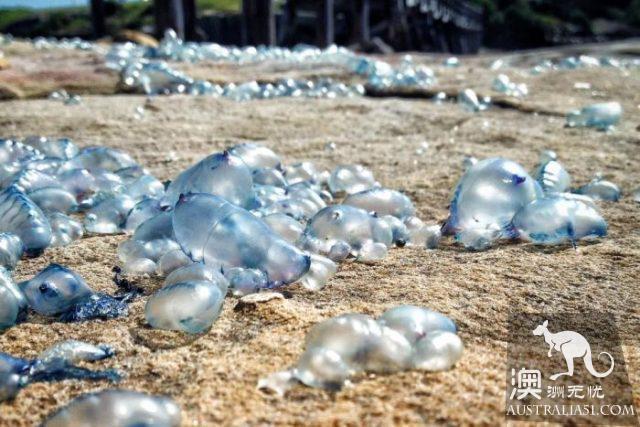Shove the last surfboard into the trunk of the car and you already have sunscreen, whether you call them togs,bathers,cossies or swimmers, always shoving a swimsuit you wear every day of the week into a beach bag.
But before you rush into the beach and dive into the surging sea, ask yourself: do I know how to recognize an offshore current or heal a jellyfish sting? To what extent should I worry about sharks? Is it just an Australian-style success ceremony or a danger that we need to take it more seriously?
According to (Surf Life Saving Australia), Australia's Surfer Life Rescue Center, 116 people drowned on Australia's coast last year.
There are more cases of non-fatal drowning leading to lifetime health complications, and more people's spine, head and other body parts injured in surfing.
So, update your knowledge of beach safety, start with advice from associate professor Robert Brown (Rob Brander), a beach expert, like preparing for a busy road, and start planning your swimming methods.
If you don't look in both directions, you won't cross the road; you can't go to sea without watching the beach for five minutes. And remember, swimming between red and yellow flags on patrolling beaches is irreplaceable.
offshore current

The dark water, which looks very calm, suggests an offshore current called Bondi Beach Express next to rocks. And further away from the beach, another offshore current can be seen. (Rob Brander)
One of the reasons for making offshore currents very covert is that they appear to be the safest places to swim.
The offshore current is the path where the waves wash water to shore and then bring the sea back to the ocean current. So they usually look dark, a relatively calm narrow path between separate white waves.
But these dark narrow paths actually mean fast moving water away from the beach to the sea.
They are very dangerous because people use up their strength when they try to swim back to shore in the opposite direction of the current, or they take inexperienced swimmers to deep waters where they cannot stand up.
Most Australians do not know how to identify offshore flows, according to the surfer Life Assistance Center; 2/3 of those who think they can identify offshore flows will admit it wrong.
"A big disconnect is that we need people to stop overestimating their abilities," said Sean (Shane Daw), coastal safety manager at the Australian Surfer Life Assistance Center.
"things can get worse, and they get worse very quickly."
Offshore currents are characterized by:
- Darker, darker waters
- A undulating sea surrounded by calm waters
- Anything that floats out of the sea, or sea water filled with waves and sand.
Associate Professor Brown stressed the importance of finding himself calm in an off-shore current.
"if you realize that you are washed out of the coast, the main practical rule is not to panic, which is very important. Your body can float on the sea and the water won't flush you to New Zealand, "he said."
"you just think of it as a journey. Relax, don't fight it, if you need it, call the lifeguard or nearby surfer for help. "
If you find yourself in an offshore current,
- Stay calm: your body will float naturally on the surface of the water, and the ocean current will not drag you into the bottom of the sea
- Keep floating on the sea and raise your arms if you need help
- If you are confident, swim in parallel to the coast in the white waters, where the water will be shallower and the waves will help you get back to shore.
- Don't try to swim back to the shore in the opposite direction of the offshore flow
sea wave
These waves are the main reason most of us go to the beach, but they may be one of the greatest dangers on the shore.
In addition to the car accident, the wave is one of the biggest causes of spinal injury in Australia, according to an associate professor of Brown.

Take five minutes to check before jumping into the sea. (ABC: Sarah Farnsworth)
The bucket wave rolls up and falls, usually at the edge of a shallow beach.
Surfers often see people falling down in surfing, causing spinal injuries, limbs, concussions and head injuries, Mr. Dao said.
A big wave is less thrilling, but as dangerous as it is, it will never really pop up, but it can go a long way to the beach and frighten you.
Children, the elderly and unconfident swimmers can be swept away by these waves. So keep your eyes on those who are not good at swimming with you, and never turn your back to the sea.
"if you take the kids, make sure you keep an eye on them. The waves can drown people in a flash, and the process is silent, "Mr. Tao said."
Pay attention to safety in the waves
- Arms in front of head jump into waves to avoid head and spine injury
- Always keep the child in a place no more than you.
- Don't turn your back to the sea.
scaleph

Ilukanzi jellyfish is small in shape, colorless and transparent. That means they can't be seen in the water at all. (ABC Far North: Mark Rigby)
No one wants to be stung by any animal, but when you get stung by a jellyfish, the level of worry you should have depends on the latitude of your area.
Lisa Gershwin, a jellyfish researcher, said:
"in general, tropical jellyfish are life-threatening; non-tropical jellyfish do not generally kill people."
"but you still need to know about jellyfish, because jellyfish don't read maps."
The main danger in tropical waters is that the tank jellyfish (box jellyfish) and the Ilukangi jellyfish (irukandji), are both deadly jellyfish, but you can hardly see them in the water.
"I was always upset when people said to me,'I know what to look for'. You think you know it scares me, "Dr. Gushwin said."
"We don't mind those jellyfish because you won't see them. What we should be careful of is something that signals us when something may happen. "
On beaches in tropical areas, warning signs include the following:
- There are jellyfish bodies on the beach: they look like crushed ice or drops of water, little jellyfish not buried in the sand
- There is a northerly wind in windless weathe
- Herds of small shrimps move like fish in shallow water, which is ideal for tank jellyfish to prey on.
- It looks like a little jellyfish. These animals are not human, but they are in symbiosis with the Ilukumqi jellyfish
- The discovery of a large number of sea lice shows that Ilukanzi jellyfish are also in the water.
These warnings do not always appear, "but if we do see them, they are completely exposed secrets," Dr. Gershwin said.
An important step to avoid being stung is to swim only on patrolling beaches. Among several tested protection options, full-body swimsuits made from spandex or divers made of neoprene are the best choice, Dr. Gershwin said.
In non-tropical areas, being stung by jellyfish can make you feel pain, but usually it doesn\'t kill you, and it\'s easier to see.
The most common human being that people play on the beach is blue, and the difference between the day of the happy day and the early return home to feed a two-person animal is as simple as looking around on the beach, said the associate professor of brand.
"the monk-hat jellyfish will disappoint you. This stinging animal will not kill you, but it will make you extremely painful, "he said."
"just check around the beach-if you see a monk-hat jellyfish washed up on the beach, you're just as likely to be stung as these jellyfish are in the water.
"you just have to look around. When I was in the sea, I looked at the water and watched for any visible bubbles produced by the monk-hat jellyfish. "
Stung in the tropics
- If you're not sure what to deal with after being stung, use vinegar to make the stinging cells useless.
- If the vinegar is not used, remove the remaining tentacles and wash the contaminated area with seawate
- Don\'t rinse it with fresh water, because it can lead to stimulation of residual prickly cells.
- A cold wet cloth in a dry plastic bag will help relieve the pain
- If the patient is not only stung or unwell, please call the lifeguard and call the lifeguard for help.
Stung in an untropical region
- Remove the remaining antennae and rinse the stung parts carefully with seawater (not fresh water)
- Don't rub the sting part
- Place the stung part in warm water for 20 minutes or use a dry wet cloth to relieve pain
- If the pain is still, or if the pain is greater (more than half the arm) or in the sensitive area (such as the eye), make a call and seek help from the lifeguard.

The jellyfish that stayed on the beach after the tide receded suggests that there are more monks and hats in the water. (Supplied: Kim Colville)
shark
Sharks are relatively rare-there have been 19 recorded shark attacks this year, one of them dead-but when sharks do appear, they receive considerable attention.
If you are in the same nearby waters as sharks, the way to reduce your risk is to avoid swimming at river exits or in dirty waters, especially after storms, because these are usually places where the marine predator is looking for food. According to Tao.
Pay attention to bait balls or fish, as sharks may follow them to prepare a full meal. One of the other conventional warnings about sharks is to pay attention to swimming in the evening and dusk. That's true, Mr. Dao said, but it may not be the reason you think.

Shark attacks attract a lot of attention, but they are relatively rare. (AAP: ScreenWest)
"it's not because sharks are more active at that time," he said.
This is more to do with reduced visibility, and more surfers preparing to leave at this time will increase your chances of meeting sharks in this event.
You can also consider the use of a shark to track the application of a mobile phone, which can show real-time discovery of a shark, although it's not all in the state.
But look at the risk of shark attacks in the right way, exclaimed associate professor Browder.
"Sharks drive me crazy. They live in the ocean, and they live there all the time. This is not a problem in many grand plans, "he said."
Shark tracking drone technology means we can learn more about where sharks are in the ocean, but they are no longer as large or dangerous as they used to be.
Associate Professor Brown says people should reduce their concerns about sharks and think more about the water itself, especially "basic things, such as offshore currents and blooming waves."
Avoid shark attacks.
- Don't swim near the dirty water or mouth, especially after the storm
- Pay attention to bait balls and flocks, which may appeal to predators
- Consider using shark tracking mobile software
- Look at shark attack risk correctly: the body of water itself is a bigger risk
Understanding the Flag
The safest place to swim is between red and yellow flags on patrolling beaches. This is where lifeguards are trained, considered to be a relatively safe area, and where they pay attention to swimmers in need.

If possible, stay on patrolling beaches and swim between red and yellow flags. (ABC News: Kathleen Dyett)
Lifeguards use other flags to give information about the beach:
- Red flag: beach closed
- Yellow flag: be careful in swimming. There are potential dangers in the waters.
- Black and white flag: area only for surfers to keep surfboards or similar boats between red and yellow flag swimming areas
Note other signs, including hazard warning signs, such as hidden rocks, management signs that mark non-permissible behavior, and safety signs that provide supplies, such as emergency beacons or first aid items.
You can also use the Australian Surfer Life Rescue Center's beach safety website and mobile software to get real-time beach information about your area.

